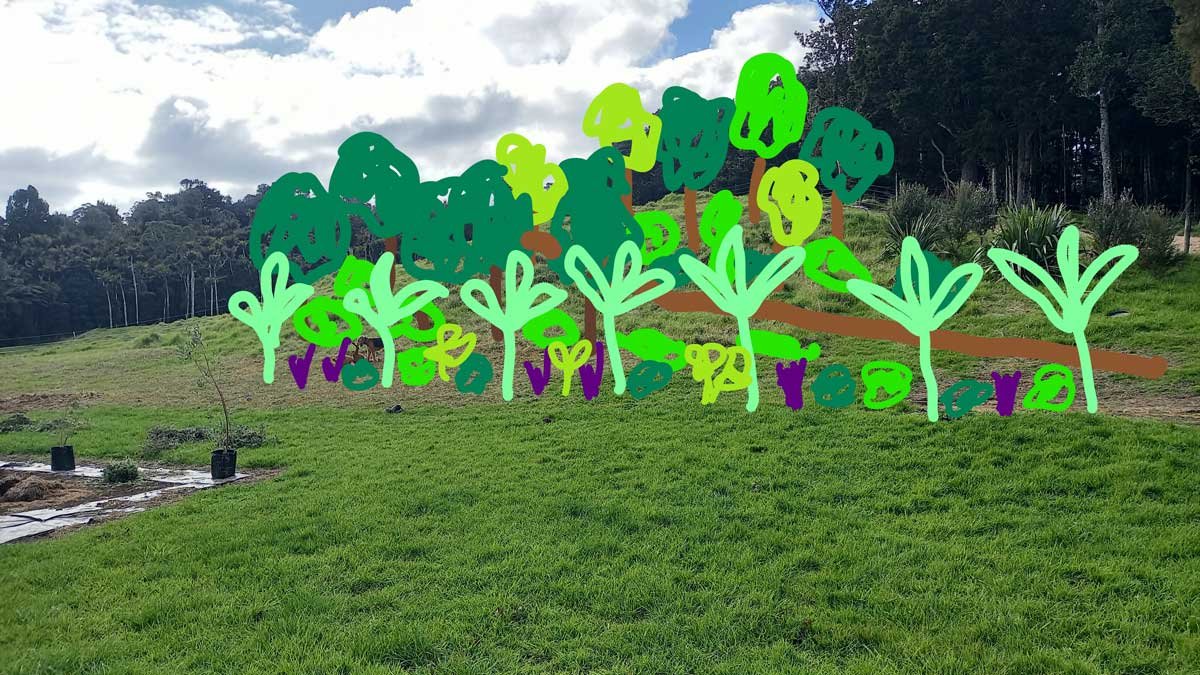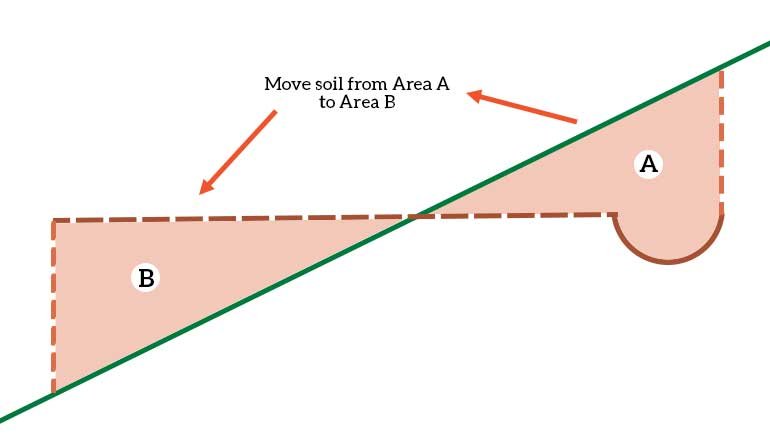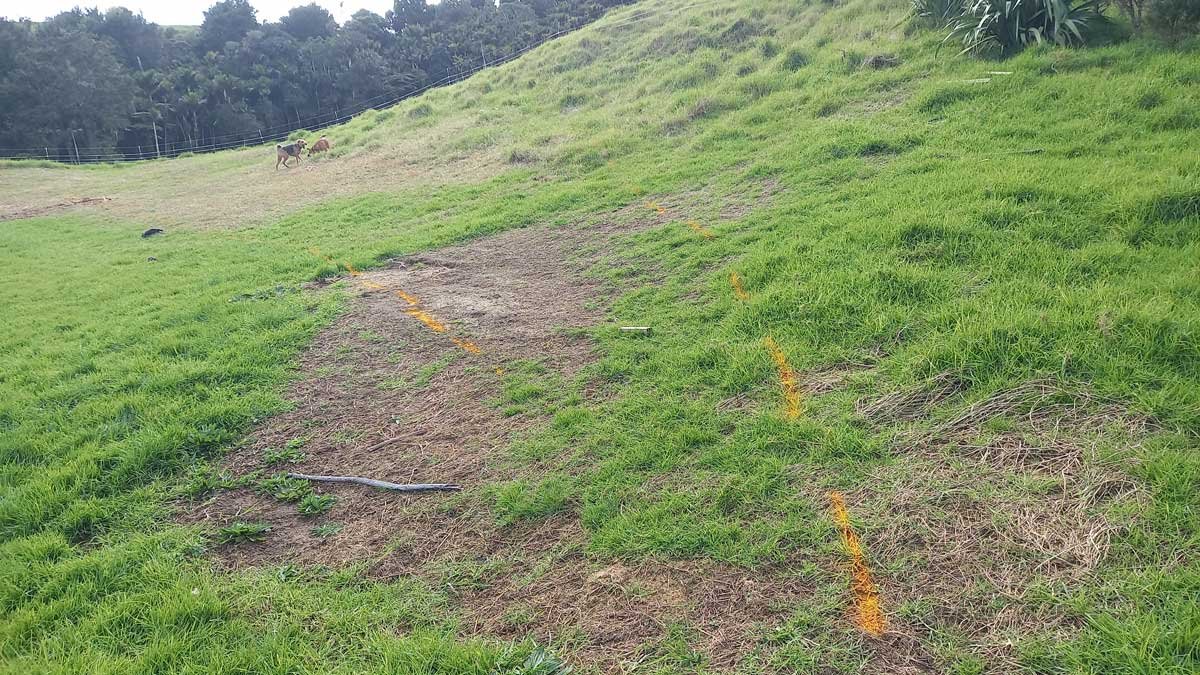There’s a hillside I’ve been looking at for three years. I keep thinking it forms an important part of what I want to do here… if only I could figure out what exactly it was I needed to do.
But lately, our dog Roxy has been using the hillside as her storage spot for her toys. She’s good at playing fetch – as long as the person throwing the toys is standing in the place she wants to return them to. Which for the moment is this hill.
So I’ve been standing on the hill and throwing toys for my dog to retrieve, and I’ve been thinking about what we might do there. Finally, I think I’ve worked it out.

Forgive my digital drawing skills, but almost all my ideas start with something that looks like this. A cartoon vision of what it might look like some day if I just get out a spade and put in the sweat.
Goals
This hillside collects a lot of rainfall. Redirecting and holding that water is important for building an actual house in the future. So the number one thing to consider is rainfall.
I’d also like a path heading up the hill. It’s the first step to connecting different parts of the property and moving away from just being a paddock for cows. For now, it’ll be a path to nowhere. Eventually, it’ll be a path to more gardens.
Then, I have a collection of plants sitting in pots that I desperately need to get into the ground. Realistically, I should have enough plants that I don’t need to buy any for this project. The challenge is to use what I’ve got.
Water
This hillside is too steep to cover in swales. Living in hill country with regular large dumps of rain, I am really reluctant to load the soil with too much water. That’s how you get landslides. Let’s try our best to avoid those.

But at the base of the hill, there’s a much lower gradient, and we can probably install two or three swales there. We’ll start with one for this project (the red line). A swale is a shallow ditch running along a contour line. The aim is that it holds water and allows it to soak into the soil.
Further, I’ll try direct water above the path down to an ‘exit point’ to form part of a larger drainage project we’re working on. So the swale should only be collecting water from below the path. Hopefully between the trees and the water mitigation, we’ll get the balance right to stabilise the hill.
Path
The blue line shows the path. The route for this path has been naturally apparent to me for a while. When I look at the hill, I can just see where the path should be. But it’s going to need some forming.
I’m hoping to move the soil on the higher side onto the lower side in a way that minimises the amount of hill I’m ‘chipping off’. The diagram below shows what I’m planning to do, though the slope is usually at less of an angle, and the path will be curved to catch runoff.

Running along the high side of the path will be a drain – filled with rocks to reduce erosion – down to where water naturally drains away from the area. Unless I find rocks as I’m digging, this will probably be the most annoying bit of the project as the place we collect rocks from is ages away, only accessible by foot, and the path is about 25m long.
I’m hoping the path will be at least 100cm wide with a 20cm width drain. But ultimately I want to do as little earthworks here as possible, so it might vary in places. This will probably be the last part I actually build – getting the plants in takes priority. But I do need to at least know where it goes so I can avoid planting trees there.
Plants
The exciting bit, really. We’re leaning on food forest/permaculture principles hard. I’m aiming to create a forest environment on the hillside. Canopy trees; small trees; bushes; herbs; root crops; and vines. A mix of edible, native, and nitrogen fixing.

Above the path, I’ll be extending the existing native planting. At the moment there’s a mature kahikatea and pūriri tree, underplanted with mānuka and harakeke by the previous owners.
I’ll be extending that with karamū, taraire, tōtara, and pūriri I’ve grown from eco-sourced seed. I’ll also put a few tagasaste in here to provide some extra fast-growing shelter, with the plan to remove them as the natives mature.
My father has mentioned a few times that this works well, and I have a few tagasaste to plant!
Between the path and the swale will be space for plants that don’t mind it a bit drier.
The canopy will be alternating olive and tagasaste trees. Under them will be tea, coffee (maybe), cherry guava, licorice, rosemary, comfrey, hops, horseradish, and Jerusalem artichoke.
Below the swale will be a row of bananas. I’ve been given 12 Cavendish pups that need planting as soon as possible. If we don’t have enough of those, the banana patch I installed our first summer here to be a banana nursery is ready to provide new stems as well.
Under the bananas I’m going to plant queen pineapple, red pineapple, canna edulis, taro, galangal, and edible ginger.
The thing that blows my mind is the only plant I’ve listed that I do not currently have growing here is the licorice. But! I do have a packet of seed in my seed collection, so I’ve sowed that in order to have the plant while not breaking my ‘rules’ about buying new plants.
But when?
Honestly? Now. The plan is probably as solid as it’s going to be and it’s really pulled itself together this week. The spray paint has been applied to show me where the path and swale go. It’s time to get out the spades.

The natives pretty much need to go in this month or next year and I don’t want to pot them again so I’ll probably start on that today if the weather allows. The rest of the plants should probably go in over spring or early summer. There’s no time like the present!
I’ll be digging the swale by hand, which I’m sure will be fun; but it’s an achievable goal. It’s 28 meters long, but I’ll just try get a few metres done each day.
I really want these plants out of my ‘plant storage area’. I need space to grow more plants! It’s hard to convince yourself to grow more for next year when you have so many waiting for a new home.
So we’ll be digging holes and crossing our fingers this whole thing works. With a bit of luck, we’ll be looking at a thriving hillside in a few years.


